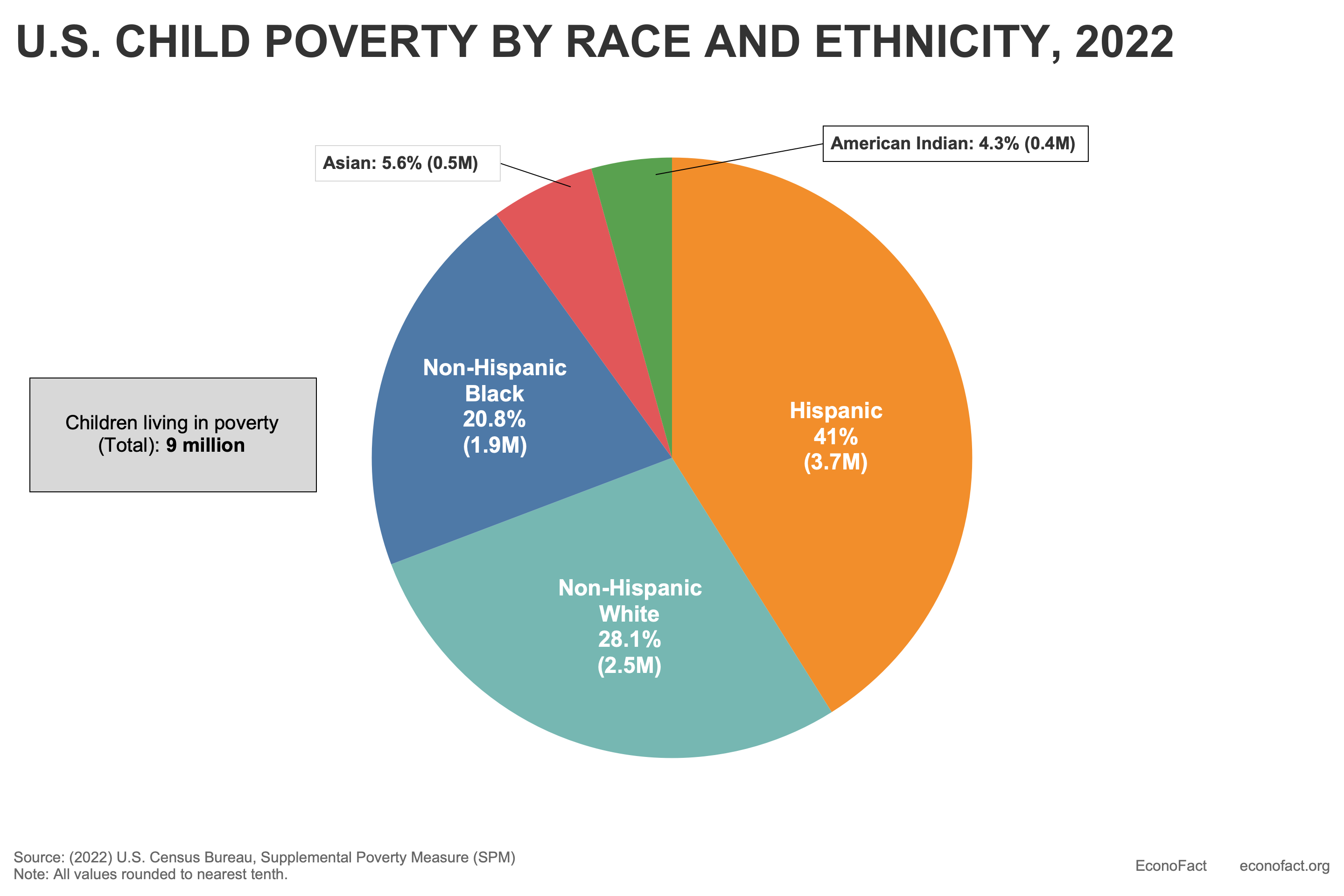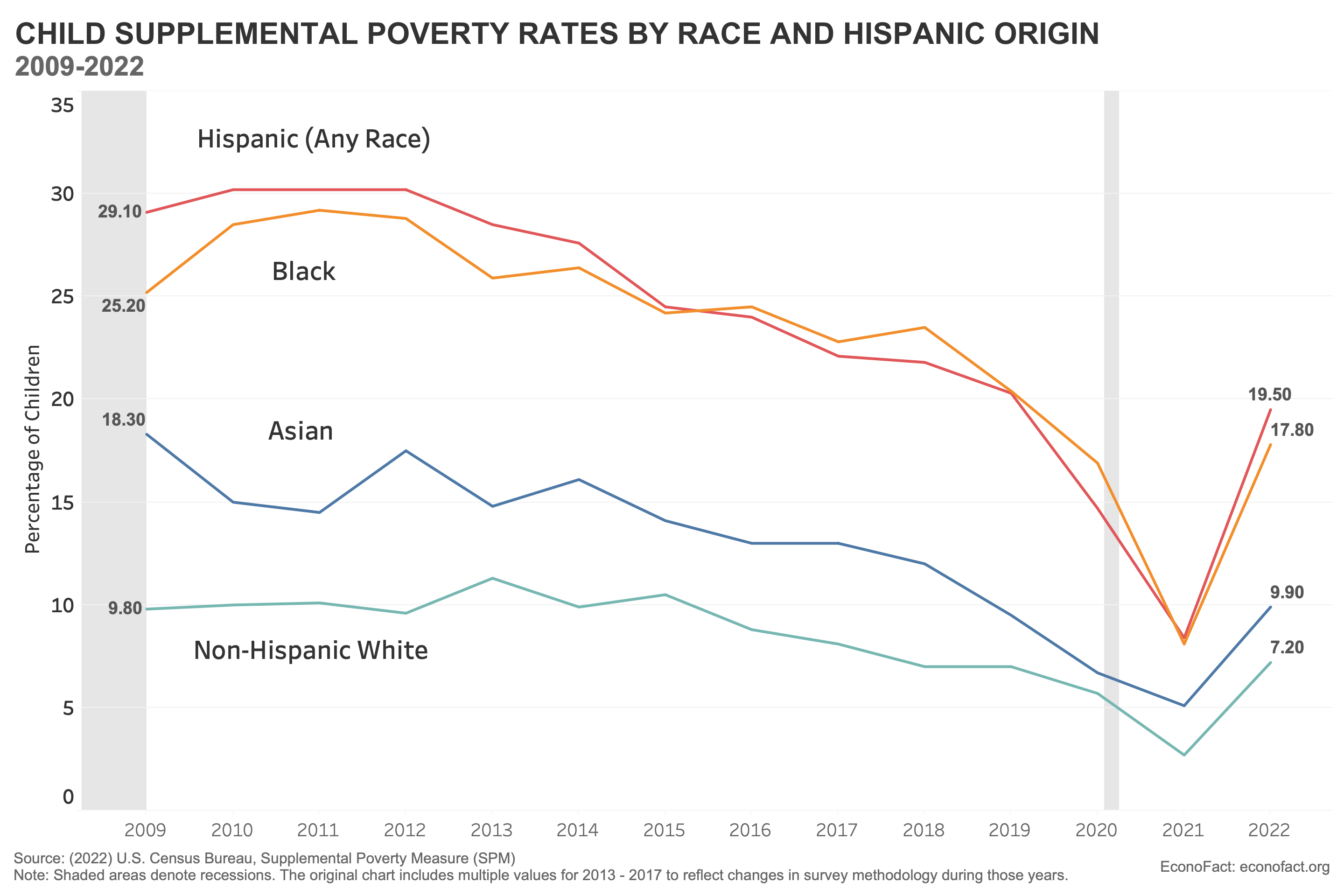Poverty Among Hispanic Children in the U.S.
Duke University and Child Trends
The Issue:
Among the four largest ethnic and racial groups in the United States, Hispanics had the highest rate of child poverty at 19.5% in 2022, as measured by the Supplemental Poverty Measure. And, Hispanic children are projected to make up an increasingly larger share of the country’s under 18 population — almost a third of U.S. children by 2050. What do these demographic patterns imply for racial and ethnic disparities in child wellbeing, for the government programs that combat child poverty, and the future U.S. workforce and economy? Hispanic children differ from other children living in poverty along several important dimensions including their family structure, parental immigration and employment, and access to safety net programs. Taking these differences into account provides a clearer picture of factors beyond income level that can impact Hispanic children’s future economic outlook, as well as the types of policies that might improve it.
Hispanic children made up 41% of the nearly 9 million U.S. children living in poverty in 2022.
The Facts:
- Of the nearly 9 million children living in poverty in the United States in 2022, Hispanic children made up the largest share — comprising 41% of those under age 18 living in poverty (see chart below). In 2022, 3.7 million Hispanic children lived in poverty, compared to 2.5 million non-Hispanic White children and 1.9 million non-Hispanic Black children, as determined by the Supplemental Poverty Measure (see here). We use the Supplemental Poverty Measure (SPM) in this analysis because, among other features, it takes into account several government programs that are designed to help low-income families. It differs from the official poverty measure (OPM) which defines poverty by comparing pretax income to a national poverty threshold and produces higher poverty estimates for those under 18. Differences between the two measures are much larger for non-Hispanic white children populations than they are for Hispanic children. This is consistent with Hispanic children’s lower receipt of safety net benefits relative to other ethnic and racial groups.

- The family’s experience with immigration plays an important role in the characteristics of poverty for Hispanic children. Among Hispanic children, poverty tends to be more common among the children of immigrants: 32% of Hispanic children with foreign-born parents lived in poverty and near poverty, compared to 21% of Hispanic children with at least one U.S.-born parent. However, the vast majority of Hispanic children (93%) are U.S.-born. The immigration status of parents can interfere with children’s access to government benefits. Undocumented immigrants are not eligible for most federal benefits and non-naturalized (i.e., non-U.S. citizen) foreign-born persons, including lawful permanent residents are also subject to restrictions on benefits (see here and here). Immigration status can impact receipt of government benefits even when families are eligible for them as a result of difficulties with trust and fear directly and implicitly through chilling effects. The immigration status of parents can also affect wages and the quality of jobs available to them.
- Despite high poverty rates, the majority of Hispanic children reside with a parent who is employed. Among Hispanic children in poverty, 74% live with at least one parent who is employed, compared to 64% of other children in poverty; at 82%, this percentage is even higher among Hispanic children who live in poverty with only foreign-born parents (authors’ calculation using the 2019 American Community Survey [ACS] data). Hispanic workers are disproportionately represented in service and blue-collar sectors (e.g., construction, service sector, and transportation), where low-wage jobs concentrate and offer few opportunities for upward mobility. They also tend to have low bargaining power to advocate for better working conditions. Latino workers who are unauthorized or authorized with a temporary work visa have lower wages and benefits and higher vulnerability to labor violations than their U.S. permanent resident and citizen counterparts. Although Hispanic parents have strong labor force attachment, their over-representation in low-wage, low-mobility, and unstable jobs can have unfavorable ripple effects on their children. While parental employment can provide children with positive role models and the benefits of additional income, low-income, long hours, evening shifts and inflexible schedules can interfere with parenting needs and place additional stress on the family; it can also lead to higher probability that the children are placed under inadequate childcare or go unsupervised (see here and here).
- While the majority of Hispanic children reside with two parents, this does not necessarily help them escape poverty. The two-parent family is typically thought of as a family structure that provides children with more resources and reduces the likelihood of poverty; however, this is not often the case for Hispanic children. Two thirds (67%) of Hispanic children live with two parents (56% married and 11% cohabiting); and 13% live with both parents and a grandparent. Despite this, poverty is higher among Hispanic children living with two parents (16%) than their two-parent family peers (9%; authors’ calculations using 2019 data from the American Community Survey).
- Participation in some safety net programs is lower among Hispanic households with children and low incomes than their Black and white peers. Accessibility factors including program administrative burden (or bureaucracy or red tape), person barriers (e.g., language and transportation); and the eligibility rules and chilling effects associated with immigration enforcement mentioned above, are associated with lower take-up among Hispanic households (particularly mixed-immigration status households) relative to other comparable racial/ethnic groups (see here, here, and here). Hispanic households’ lower participation rates have been documented for key anti-poverty programs such as the Supplemental Nutrition Assistance Program (SNAP, formerly known as Food Stamps) and Medicaid as well as refundable tax credits, and emergency relief, among others. In light of child care affordability, for example, child care assistance funded by the Child Care and Development Fund underserves eligible Hispanic families: while 35% of children deemed eligible for assistance were Hispanic, only 20% of those who actually received assistance were Hispanic — a 15 percentage point difference, according to a GAO report (see page 26). In addition, although disproportionately bearing the brunt of recessions, Latino households have been the least likely to receive benefits that would help them weather economic shocks, including initial Economic Impact Payments, the 2021 expanded Child Tax Credit, and unemployment benefits.
What this Means:
Hispanic children account for the largest ethnic share of all U.S. children living in poverty, although their families have characteristics that in other populations are associated with lower rates of poverty. This high poverty rate is concerning and could have lasting effects on the health, education and economic security of this population. A more in-depth understanding of Latino families, their employment and family characteristics, use of social programs, and immigration complexity might improve strategies for combating Latino child poverty; some of these may include improving the quality of jobs, sustaining stable earnings growth, supporting child care access; and reducing burdens that get in the way of utilizing safety net programs.
Like what you’re reading? Subscribe to EconoFact Premium for exclusive additional content, and invitations to Q&A’s with leading economists.

